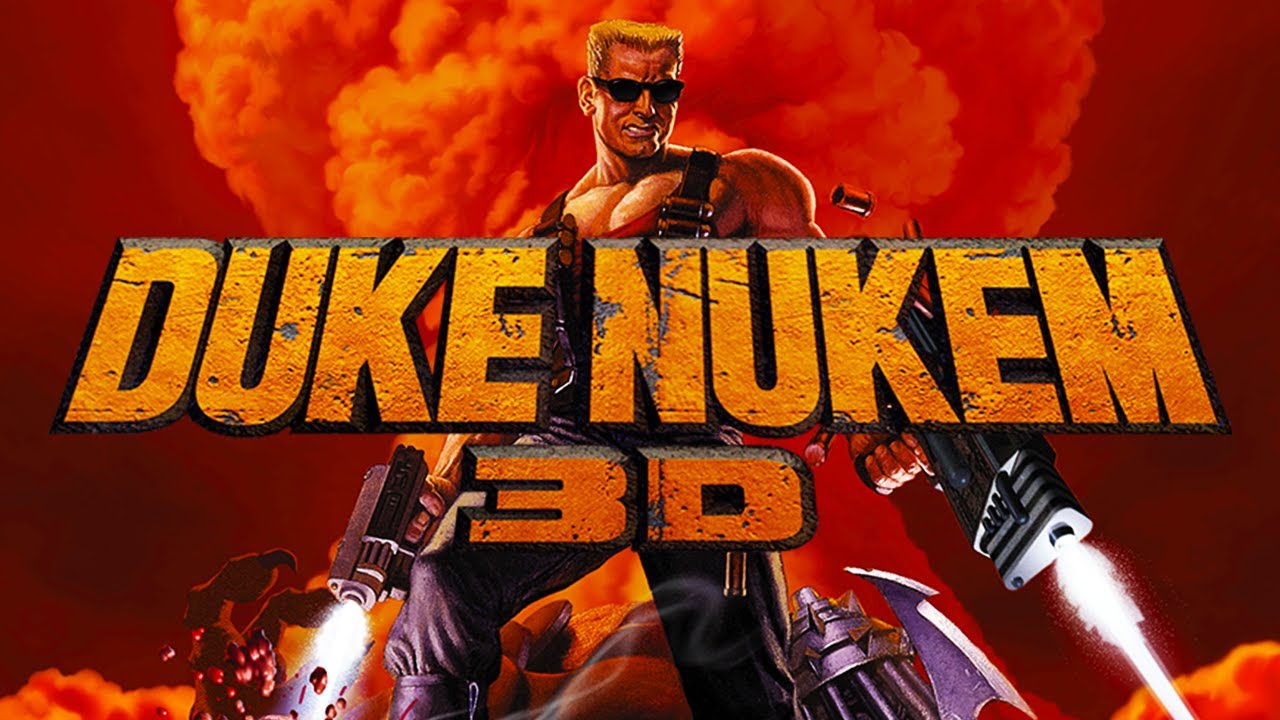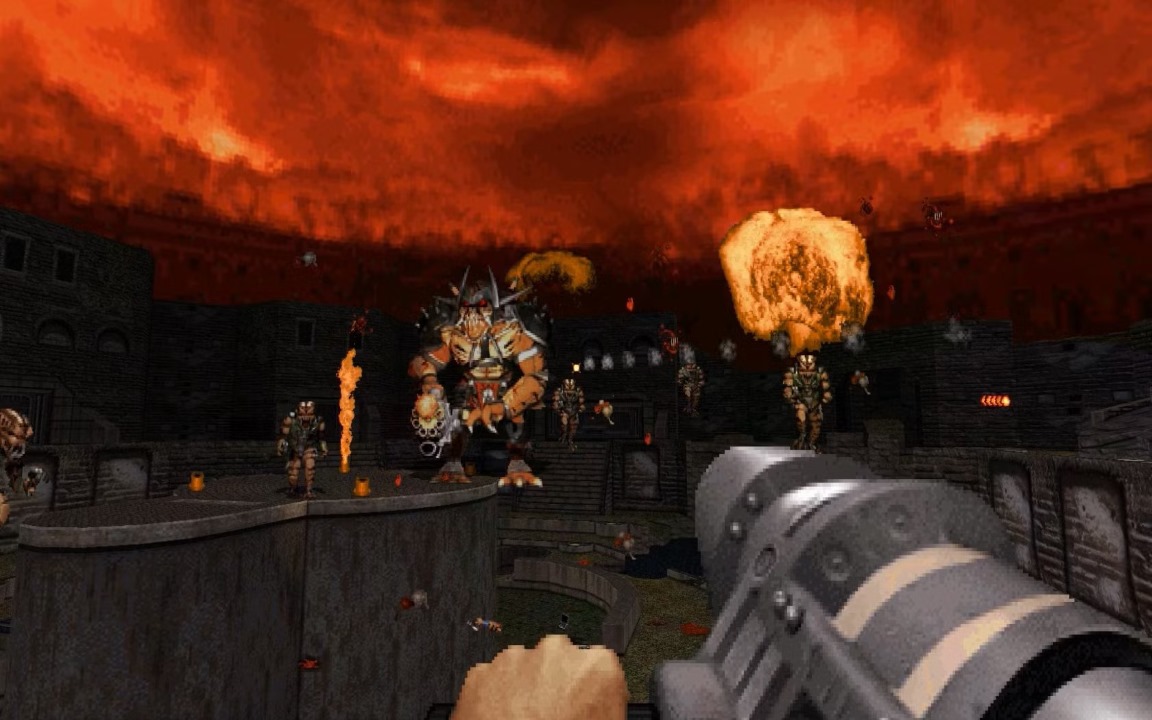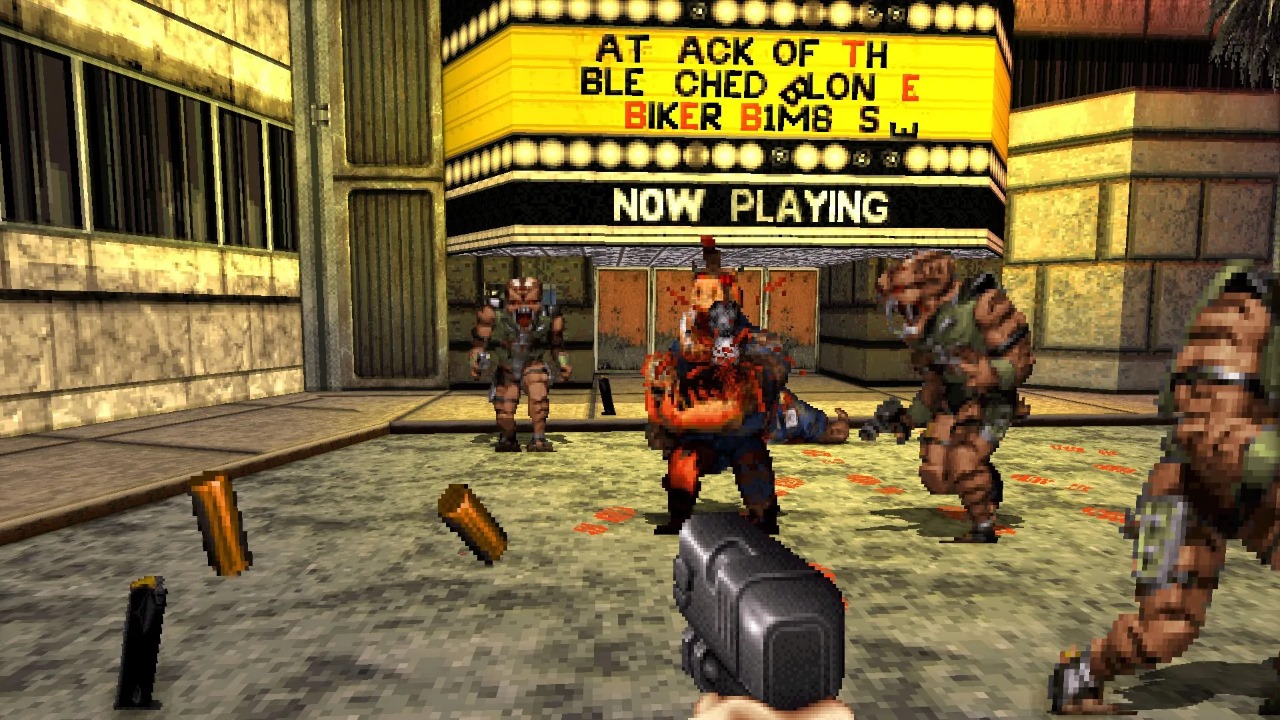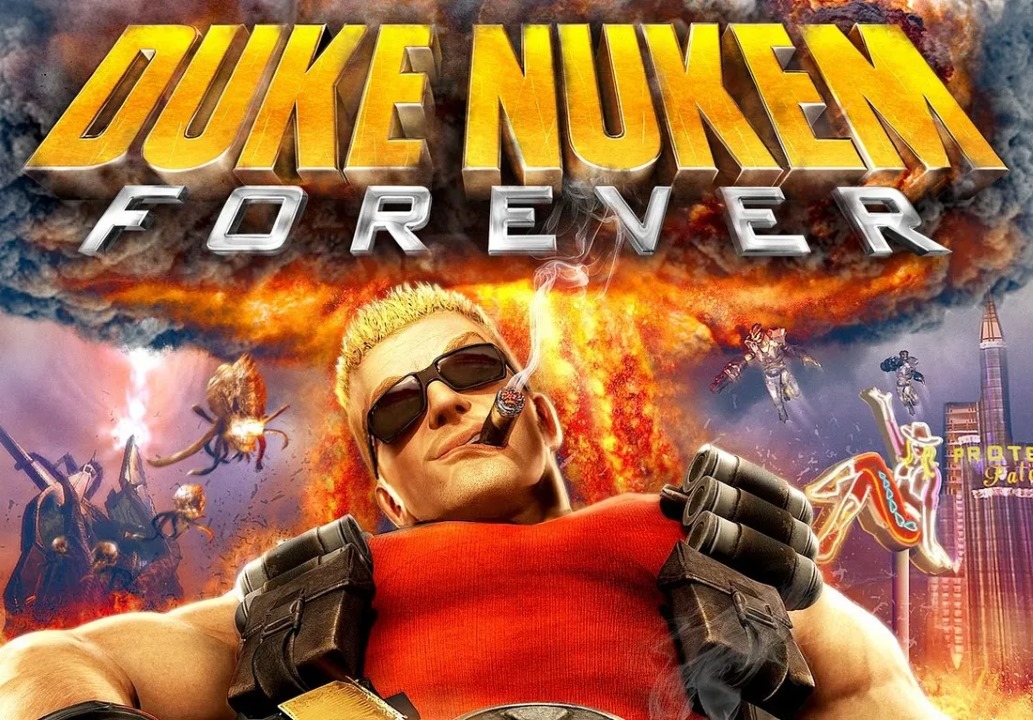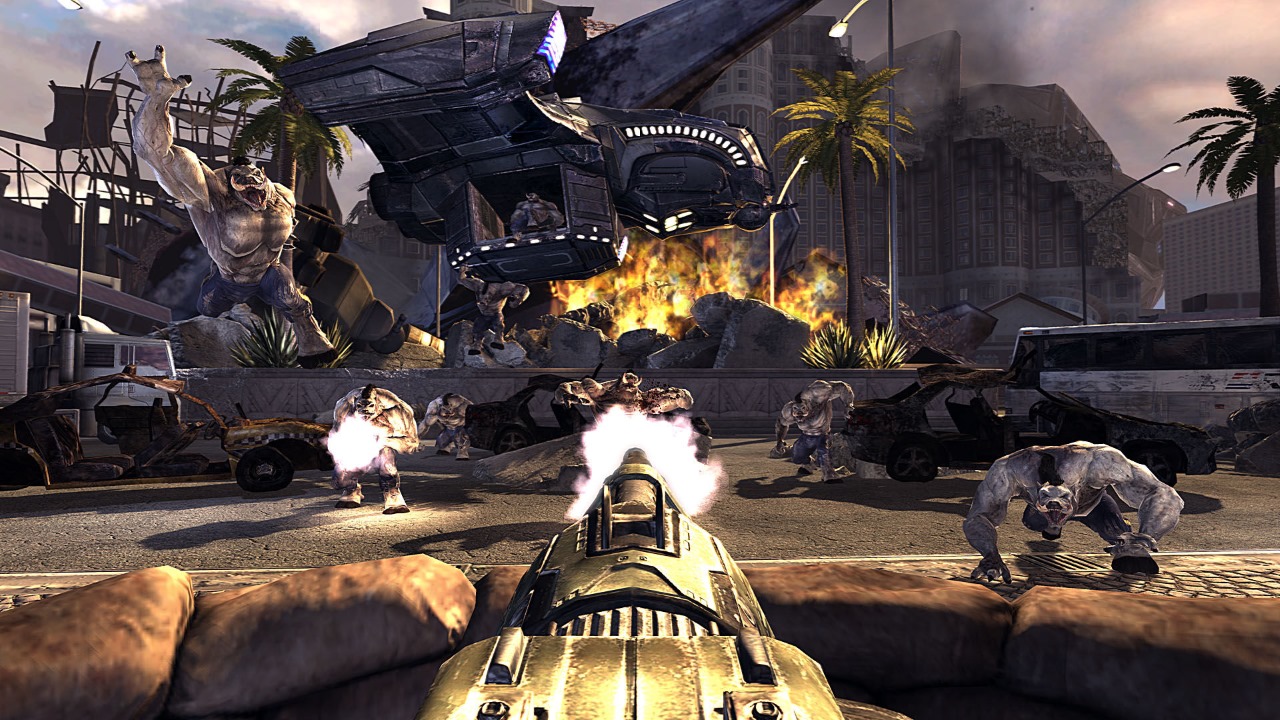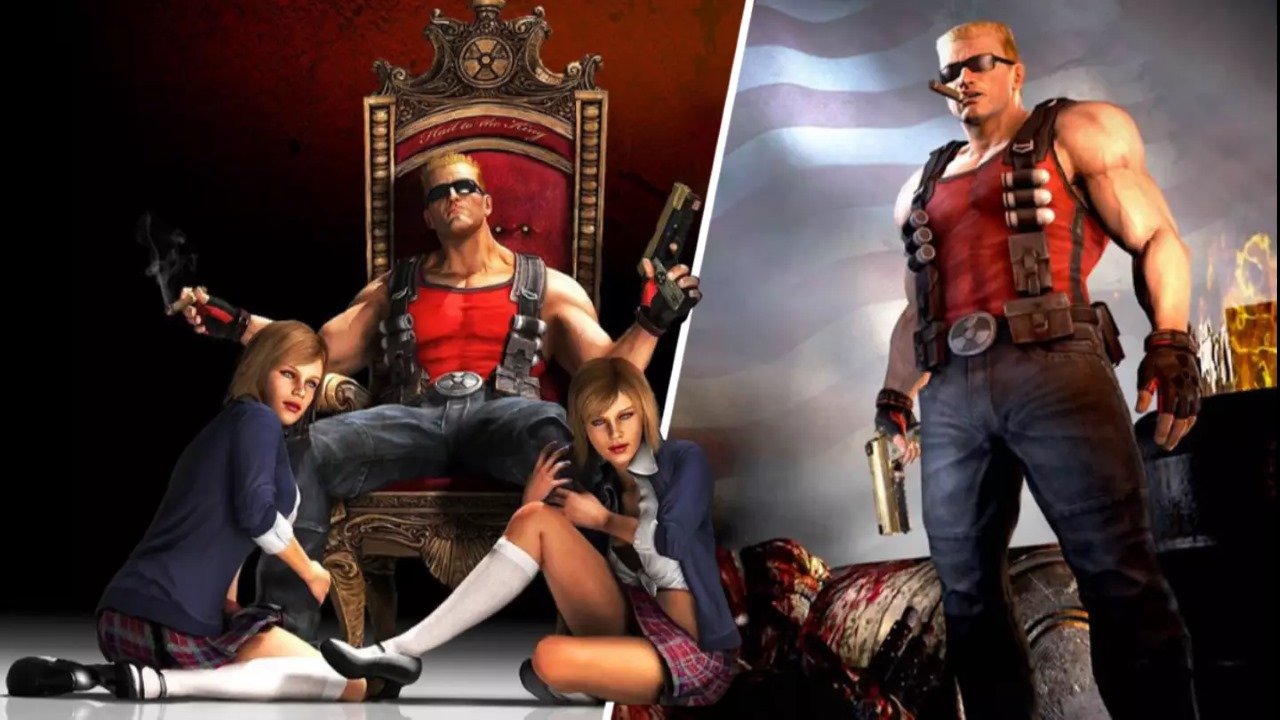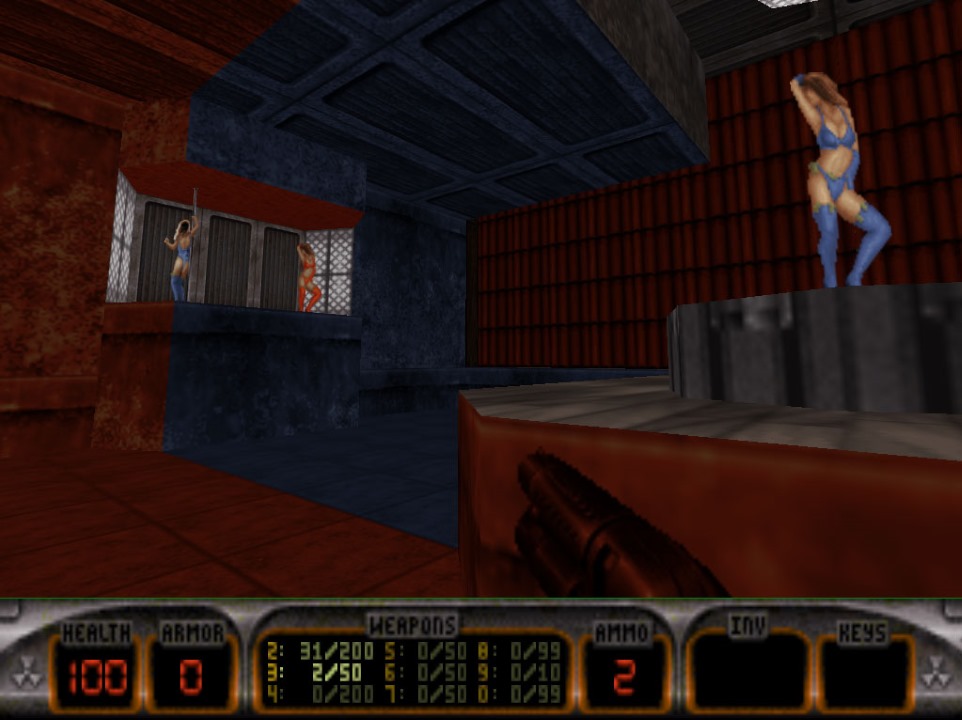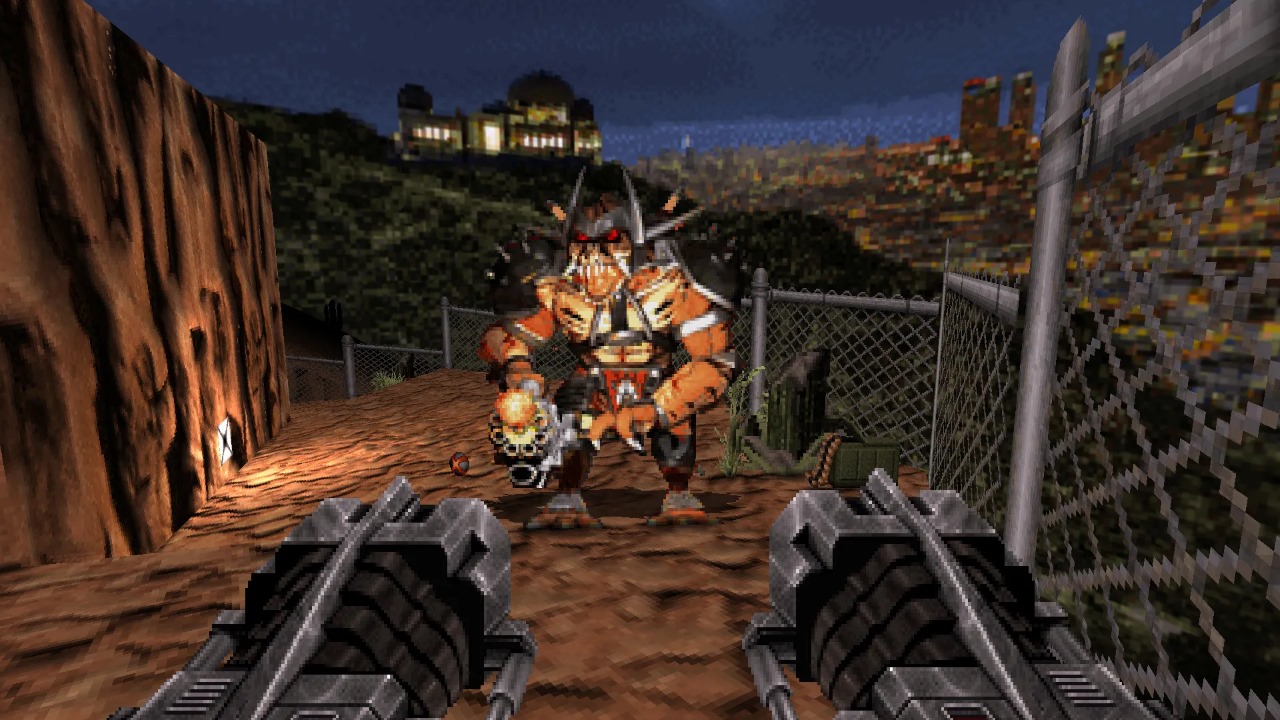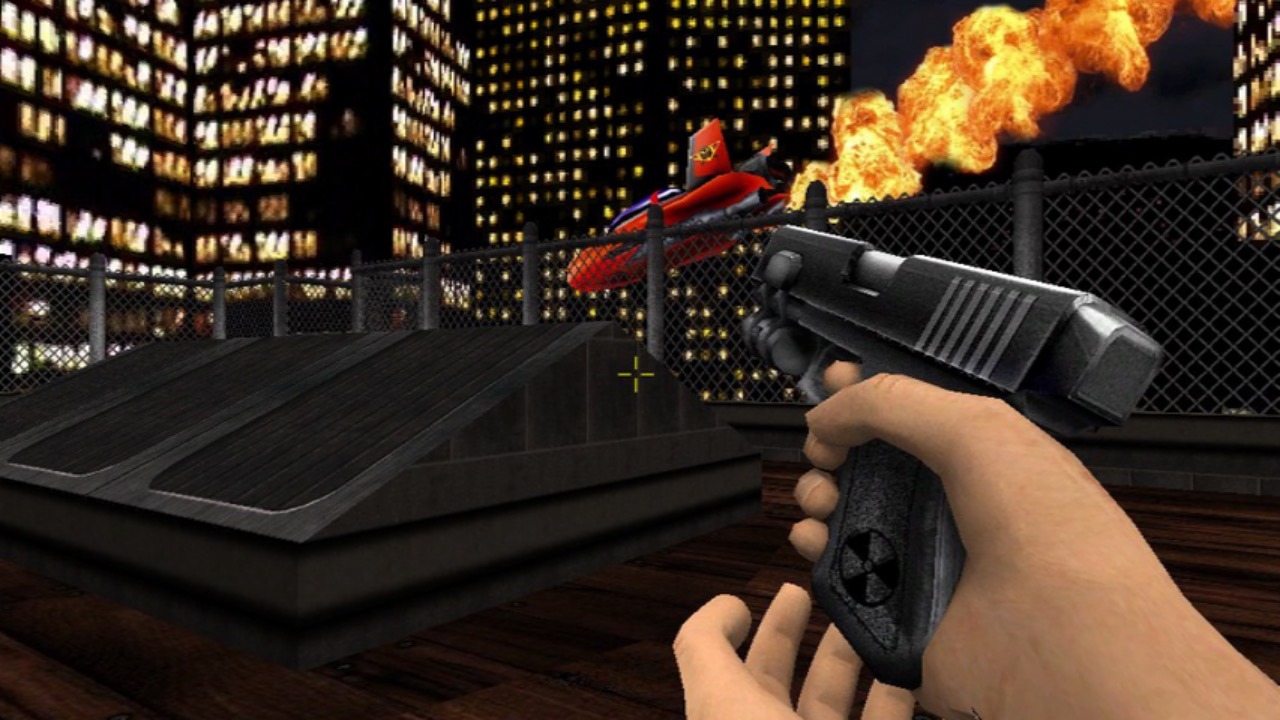In the mid-90s, when first-person shooters were evolving rapidly but often lacked personality, Duke Nukem 3D burst through the door with a cigar in one hand and a shotgun in the other. Released in 1996 by 3D Realms, this game didn’t just add another notch to the belt of classic shooters—it blew a hole in the wall and rewrote what people expected from the genre. It was chaotic, irreverent, brutally fun, and packed with charisma.
At a time when many FPS protagonists were voiceless avatars—mere weapons with legs—Duke Nukem brought swagger. He didn’t just shoot aliens. He taunted them. He dropped one-liners mid-battle, flexed in mirrors, and quoted action movies with a grin that bordered on parody. He wasn’t just part of the game—he was the game.
Beyond Duke’s personality, the game introduced elements that pushed the genre forward: interactive environments, multi-layered level design, alternate firing modes, and an arsenal that felt dangerous in all the right ways. It wasn’t just about shooting your way through a corridor. It was about blowing holes in walls, flushing toilets, watching strippers, and laughing maniacally while sending pig cops to hell.
Even after decades, Duke Nukem 3D hasn’t faded into obscurity. It’s become one of the most iconic titles in the FPS hall of fame—both for what it did right, and for the bold, brash way it refused to be like anything else. In a genre often obsessed with grit and realism, Duke gave players something else: attitude.
Development History: From Platformer to FPS Icon
Before Duke Nukem was the king of catchphrases and chaos, he was just another pixelated hero in a side-scrolling shooter. The original Duke Nukem (1991) and Duke Nukem II (1993) were 2D platformers—fun, but not revolutionary. Then came Doom, and the world of gaming changed overnight. 3D Realms, always eager to push boundaries, saw the potential in the emerging FPS genre and decided it was time for Duke to make the leap—both literally and figuratively—into three dimensions.
Built using Ken Silverman’s Build engine, Duke Nukem 3D was a technical marvel for its time. While not truly 3D in the modern sense, the engine allowed for room-over-room architecture, slope rendering, and highly interactive environments—features that made levels feel alive in a way Doom hadn’t quite reached. Players could shoot lights out, interact with arcade machines, break mirrors, and even manipulate security cameras. These weren’t gimmicks—they were immersive details that made every level feel like a living space.
One of the boldest decisions the team made was to focus on urban environments rather than fantasy or sci-fi spaceships. The first episode drops players in a post-apocalyptic Los Angeles filled with neon signs, adult theaters, alleyways, and high-rises. It was gritty, grounded, and filled with personality. It felt real—but real with a heavy-metal, B-movie twist.
The game’s humor, violence, and sexual innuendos weren’t accidents. They were deliberate decisions to lean into mature themes—something rare at the time. Duke Nukem wasn’t just a response to other FPS titles; he was a full rebellion against them. And with a lean, motivated team behind him, the result was something explosive.
Gameplay Mechanics: A New Standard for Interactivity
The heart of Duke Nukem 3D lies in its gameplay—fast, fluid, and full of surprises. While many shooters of its time focused solely on run-and-gun action, Duke’s world felt lived-in. From the very first level, players realized this wasn’t a game about just reaching the exit—it was about exploring, breaking, manipulating, and causing chaos in the most creative ways possible.
Level design in Duke Nukem 3D was a standout feature. These weren’t just mazes full of enemies. They were complex, multi-tiered spaces with secrets hidden behind destructible walls, vent shafts leading to new areas, and interactive objects like light switches, monitors, and slot machines. You could flush toilets, read security monitors, blow open new paths with explosives, or sneak through air ducts to flank enemies. It encouraged players to think, explore, and replay.
The weapons, too, were more than just the standard fare. You had your reliable pistol and shotgun, sure—but then there was the RPG for devastating splash damage, the Shrinker that turned enemies into stompable bugs, and the Freezethrower, which let you shatter frozen foes into gory fragments. Pipe bombs could be remotely detonated for clever ambushes, and the Devastator—a double-barreled rocket launcher—was pure power fantasy.
On top of that, players had access to useful gadgets: night vision goggles, portable medkits, jetpacks, scuba gear. These weren’t just for show. Many were essential for navigating specific levels or surviving tougher encounters. The portable medkit, for instance, let players heal on demand, adding a layer of strategy that most other shooters ignored.
Then there was the enemy design: a rogue’s gallery of grotesque, imaginative aliens. The pig cops, enforcers, octabrains, and protector drones weren’t just bullet sponges—they had unique behaviors, sounds, and animations. Fighting them was intense, often requiring quick reflexes and smart use of your gear.
All of this came together to make Duke Nukem 3D a playground of destruction. One that felt dynamic, rewarding, and consistently engaging—even decades later.
Character and Tone: Duke's Irreverent Persona
If there’s one thing that truly set Duke Nukem 3D apart from every other FPS of its time, it was Duke himself. In a world of silent protagonists and grim narratives, Duke was a walking, talking, ass-kicking cartoon. He wasn’t deep. He wasn’t sensitive. But he had more personality per pixel than most of the gaming heroes that came before or after him.
Voiced by Jon St. John, Duke’s one-liners became instant classics. “It’s time to kick ass and chew bubblegum... and I’m all outta gum” wasn’t just a quote—it was a manifesto. He borrowed lines from They Live, Evil Dead, and every Schwarzenegger movie ever made, delivering them with tongue firmly planted in cheek. He wasn’t here to save the world with solemnity—he was here to blow it up and laugh about it.
But beneath the bravado, there was something smart going on. Duke Nukem 3D was self-aware. It parodied macho hero tropes while also embracing them. It was absurd, exaggerated, and often offensive—but it knew it. This tone permeated everything: the strippers you could tip for a dance, the jokes spray-painted on walls, the references to other games and films. It was crude, sure—but never lazy.
This irreverent attitude divided critics, but for players, it felt fresh. It was a reminder that games didn’t have to be serious to be fun. They could be messy, chaotic, and loud—and still be brilliant.
Graphics and Sound: Crafting a Memorable Atmosphere
For a game released in 1996, Duke Nukem 3D punched far above its weight in the audio-visual department. Powered by the Build engine, it didn’t offer true 3D in the modern sense—but it cleverly faked it with sector-based rendering, sloped floors, destructible environments, and room-over-room illusions. The result was a game that felt three-dimensional, despite being technically 2.5D.
The visuals had a dirty, worn-down look that matched the post-apocalyptic tone. Urban decay, busted neon signs, smoke-filled strip clubs, sewers crawling with enemies—it all gave the game a gritty atmosphere without ever feeling overly dark or oppressive. The lighting effects were basic by today’s standards, but the sheer amount of environmental detail and destructibility was impressive. You could shoot out lights, break mirrors, smash machines, or blow holes in walls to access secrets. Even decades later, those elements still make the levels feel tactile and reactive.
Sound was a crucial piece of the puzzle. The soundtrack—composed primarily by Lee Jackson, with contributions from Doom veteran Bobby Prince—combined driving rock, industrial synths, and eerie ambiance. Tracks like “Grabbag” (Duke’s iconic theme) became instantly recognizable, almost inseparable from the character’s identity. The music never overstayed its welcome; it kicked in when it needed to and let the atmosphere breathe when the moment called for it.
And then there was the voice work. Jon St. John’s performance as Duke was a game-changer. He wasn’t just a soundboard of action movie quotes—he brought a rhythm, a grin, a tone that gave Duke life. Sound effects were also finely tuned. The chunky boom of the shotgun, the hiss of the Shrinker, the squelch of an octabrain exploding—it all had weight and feedback. The game sounded as alive as it looked.
For a mid-’90s shooter, the technical execution of Duke Nukem 3D was top-tier. It wasn’t just what they showed—it was how they sold the illusion. And for the players inside that illusion, it was unforgettable.
Reception and Legacy: Cementing a Cult Classic
When Duke Nukem 3D launched, it made an immediate impact. Reviewers praised its fast-paced action, creative level design, and boundary-pushing personality. PC Gamer, GameSpot, and Next Generation all gave it strong scores, noting how it pushed the FPS genre forward. Players were equally enthusiastic, and the game quickly found a loyal, vocal fanbase.
It wasn’t just another Doom clone—it was a Doom evolution. Where Doom gave players brutal corridors and demonic terror, Duke Nukem 3D gave them cities to explore, jokes to laugh at, and aliens to blow apart with a wink. It felt alive in a way few shooters did. That feeling—of total freedom and reckless fun—set it apart and gave it long-term staying power.
Over time, Duke Nukem 3D earned its reputation as one of the defining FPS games of the 1990s. It influenced dozens of titles, not just in gameplay, but in tone. You could see its DNA in Shadow Warrior, Blood, and Redneck Rampage, all Build-engine siblings with their own cult status. Even outside that circle, you could feel its impact on how shooters approached humor, character, and environmental design.
It’s also a game that never quite went away. It’s been re-released multiple times, modded endlessly, and talked about on forums, YouTube retrospectives, and speedrunning events. Unlike many of its contemporaries, Duke’s world wasn’t bound to one generation—it adapted, survived, and stayed relevant.
Despite some outdated jokes or mechanics, most players coming back to Duke Nukem 3D today find a game that still plays shockingly well. It’s tight, responsive, visually distinct, and filled with clever design choices that even modern shooters sometimes forget.
Legacy doesn’t always belong to the biggest or most polished. Sometimes, it belongs to the game that left the deepest footprint. And Duke Nukem 3D? It kicked that door down.
What Came After Duke Nukem 3D? A Full Timeline of Sequels and Spin-offs
Of course, Duke Nukem 3D wasn’t the end of the story. Over the years, Duke returned in a number of sequels, spin-offs, and even a long-delayed official follow-up. Here’s how his post-3D timeline unfolded:
1. Duke Nukem: Time to Kill (1998)
-
Platform: PlayStation
-
Perspective: Third-person shooter
-
Premise: Duke travels through time to stop alien threats in the Old West, Ancient Rome, and more.
-
Tone: Over-the-top, full of Duke's signature humor
-
Notable For: First major departure from FPS to third-person
2. Duke Nukem: Zero Hour (1999)
-
Platform: Nintendo 64
-
Perspective: Third-person shooter
-
Premise: Duke defends Earth from a time-ripping alien invasion
-
Strengths: More refined gameplay than Time to Kill, better visuals and mission variety
-
Reception: Well-received among N64 shooter fans
3. Duke Nukem: Land of the Babes (2000)
-
Platform: PlayStation
-
Perspective: Third-person shooter
-
Premise: Duke saves Earth’s remaining women from mutated aliens
-
Criticisms: Repetitive level design, dated mechanics
-
Tone: Cranked-up humor with heavy innuendo
4. Duke Nukem: Manhattan Project (2002)
-
Platform: PC (later Xbox Live Arcade)
-
Perspective: 2.5D side-scrolling action
-
Premise: Duke fights “GLOPP” mutants in New York
-
Style: Cartoonish visuals, fast platforming, and classic Duke charm
-
Reception: Positive; seen as a return to form
5. Duke Nukem Advance (2002)
-
Platform: Game Boy Advance
-
Perspective: First-person shooter
-
Premise: A new mission against alien threats adapted for handheld play
-
Note: Toned down for the platform but still featured Duke’s attitude
-
Reception: Solid gameplay, though scaled down
6. Duke Nukem Forever (2011)
-
Platforms: PC, PlayStation 3, Xbox 360
-
Perspective: First-person shooter
-
Development: Announced in 1997, released after 14 years of delays
-
Expectations: Sky-high due to long development
-
Reality: Outdated design, mixed-to-poor reviews
-
Legacy: One of gaming’s most infamous development stories, but still a piece of Duke history
7. Duke Nukem 3D: 20th Anniversary World Tour (2016)
-
Platforms: PC, PlayStation 4, Xbox One, Nintendo Switch
-
What It Includes:
-
The original Duke Nukem 3D
-
A brand-new fifth episode created by original developers
-
Updated visuals, re-recorded voice lines, new soundtrack remixes
-
-
Why It Matters: The most polished, modern way to replay the classic—and a love letter to the fans
Expansions and Re-releases: Keeping the Legacy Alive
After the original release, Duke Nukem 3D didn’t stop evolving. It was one of the earliest FPS titles to fully embrace the idea of expansions and re-releases, keeping the game alive well into the 2000s and beyond.
The first major add-on was the Plutonium Pack, which added a fourth episode and more levels, monsters, and weapons. It was eventually bundled into the Atomic Edition, which became the definitive version for many fans. The additional content didn’t just add more levels—it introduced even more interactivity, more complex design, and kept the bar high for quality.
In the 2010s, the game saw renewed attention with the release of the Megaton Edition, published by Devolver Digital. It bundled the original game with its expansions, included modern features like OpenGL rendering, widescreen support, and online multiplayer. For many, this was the ideal way to play Duke in the modern era.
Then came the 20th Anniversary World Tour, developed in part by original team members. This version introduced an all-new fifth episode, brand-new levels designed by the original creators, re-recorded voice lines by Jon St. John, and a remixed soundtrack by Lee Jackson. It also came with developer commentary and modern enhancements—proof that the team still had passion for Duke’s world.
Across all these versions, Duke Nukem 3D remained playable, relevant, and fun. Few shooters from the '90s have had this many revivals—especially with such care put into each one. And it speaks to the game’s lasting influence: players want to come back, again and again, because the experience still delivers.
Whether you’re booting up the original DOS version or the latest HD port, Duke’s still kicking ass—and somehow, the gum never runs out.
Modding Community: Extending the Game's Lifespan
If there's one thing that’s kept Duke Nukem 3D alive far beyond its original shelf life, it’s the modding community. From the earliest days of its release, fans and amateur developers began tinkering with the game—creating custom maps, new weapons, total conversions, and even full narrative experiences. And 3D Realms didn't just tolerate it—they embraced it, fostering a culture of creativity that’s still thriving decades later.
Thanks to the flexibility of the Build engine, modding Duke was surprisingly accessible. Fans created new campaigns, multiplayer arenas, character skins, and ridiculous weapon mods. Total conversions like Duke Hard, The AMC TC, and Alien Armageddon are just a few standout examples of how expansive community-driven content has become. These weren’t just gimmicky edits—many were as polished and inventive as commercial releases.
The rise of source ports like EDuke32 pushed things even further. With support for high resolutions, modern controls, scripting extensions, and advanced lighting effects, EDuke32 became the foundation for a new wave of mods and fan-made expansions. It made the game more accessible to new players while giving veterans the tools to reimagine the Duke experience in increasingly ambitious ways.
Fan-made HD texture packs, new enemy AI scripts, and even VR experiments have kept the experience evolving. It’s no exaggeration to say that Duke Nukem 3D would not be as remembered or revered today without the work of its dedicated community. The modding scene didn’t just extend the game's lifespan—it helped transform it into a living legacy that continues to grow.
For fans, this also means Duke Nukem 3D is almost endlessly replayable. Whether you're jumping into a classic run, trying out a full-conversion fantasy mod, or playing deathmatch on a custom map, there’s always something new to experience. That’s rare for a game from 1996. And it speaks volumes about just how beloved—and creatively fertile—this universe still is.
Controversies and Criticisms: Navigating Mature Content
Duke Nukem 3D didn’t just grab attention because of its gameplay—it grabbed headlines, parental outrage, and the scrutiny of censors worldwide. From the start, Duke was a lightning rod for controversy, thanks to his sexual innuendos, violence, and frequent encounters with strippers and adult-themed content. For better or worse, this became part of the game's identity.
Critics accused the game of being crude, sexist, and exploitative. The ESRB slapped it with an “M for Mature” rating, and in some countries, the game was outright banned or censored. Strip clubs were modified. Pixelated nudity was blurred or removed. Some of the violence was toned down in certain ports. But to many fans, that was missing the point.
Yes, Duke was outrageous. But he was also self-aware. The game wasn’t just indulging in machismo—it was parodying it. It poked fun at action movie tropes, exaggerated its edginess, and never tried to present itself as something it wasn’t. That didn’t mean everyone was okay with it—but to its target audience, it was bold, rebellious, and hilarious.
Even today, discussions around Duke Nukem 3D are tinged with that same duality. It’s a game that’s undeniably problematic in places—especially when viewed through a modern lens—but it’s also a product of its time, and a mirror to the over-the-top media culture it was born from. It didn’t try to be tasteful. It tried to be wild. And in that, it succeeded.
For many players, Duke's crass humor and over-the-top antics weren’t offensive—they were refreshing. They were part of what made the game stand out in a sea of sterile shooters. That rebellious tone? It was part of the fun.
Duke Nukem 3D’s Place in Gaming History
Today, Duke Nukem 3D stands as more than just a cult classic—it’s a defining moment in FPS history. Not because it was the first to do what it did, but because it did it louder, smarter, and with more style than most of its peers. It wasn’t afraid to be bold. It didn’t care about being polite. It cared about being fun—and unforgettable.
It helped reshape what shooters could be. It added verticality, interactivity, personality, and freedom to a genre that was still figuring itself out. And it introduced a main character who talked, taunted, and left a lasting impression. Whether you loved him or hated him, Duke Nukem became iconic.
It’s easy to forget just how influential this game was. Modern games with destructible environments, interactive objects, cheeky tone, or bombastic protagonists? They’re all walking down paths Duke helped pave. And while the series’ later entries didn’t reach the same heights (Duke Nukem Forever, anyone?), the shadow cast by Duke Nukem 3D is long—and earned.
For players who grew up in the '90s, this game was pure mayhem wrapped in pixels. And for newer gamers discovering it through re-releases or mods, it’s a time capsule—one that still hits harder than you'd expect.
Some games fade into history. Others become footnotes. But Duke Nukem 3D? It’s still standing, sunglasses on, finger on the trigger, ready to kick ass all over again.
Duke Nukem 3D – Game Details
-
Genre: First-person Shooter (FPS)
-
Release Year: 1996
-
Platforms:
-
Original: MS-DOS
-
Later Ports: Mac OS, Windows 95, Sega Saturn, PlayStation, Nintendo 64, Game.com
-
Modern Availability:
-
Windows, PlayStation 4, Xbox One, Nintendo Switch – via Duke Nukem 3D: 20th Anniversary World Tour
-
Steam and GOG – Legacy versions and Megaton Edition (note: delisted but still accessible to owners)
-
-
-
Developer: 3D Realms
-
Publisher: GT Interactive (original), Devolver Digital (Megaton), Gearbox Software (World Tour)
-
Game Engine: Build Engine
-
Age Rating: ESRB: M (Mature)
-
Player Modes: Single-player, Multiplayer (LAN, Online, Co-op, Deathmatch depending on version)
-
Awards/Nominations:
-
PC Gamer’s Game of the Year 1996
-
Inducted into PC Gamer’s Hall of Fame
-
Numerous retro awards and FPS retrospectives acclaiming its impact
-

